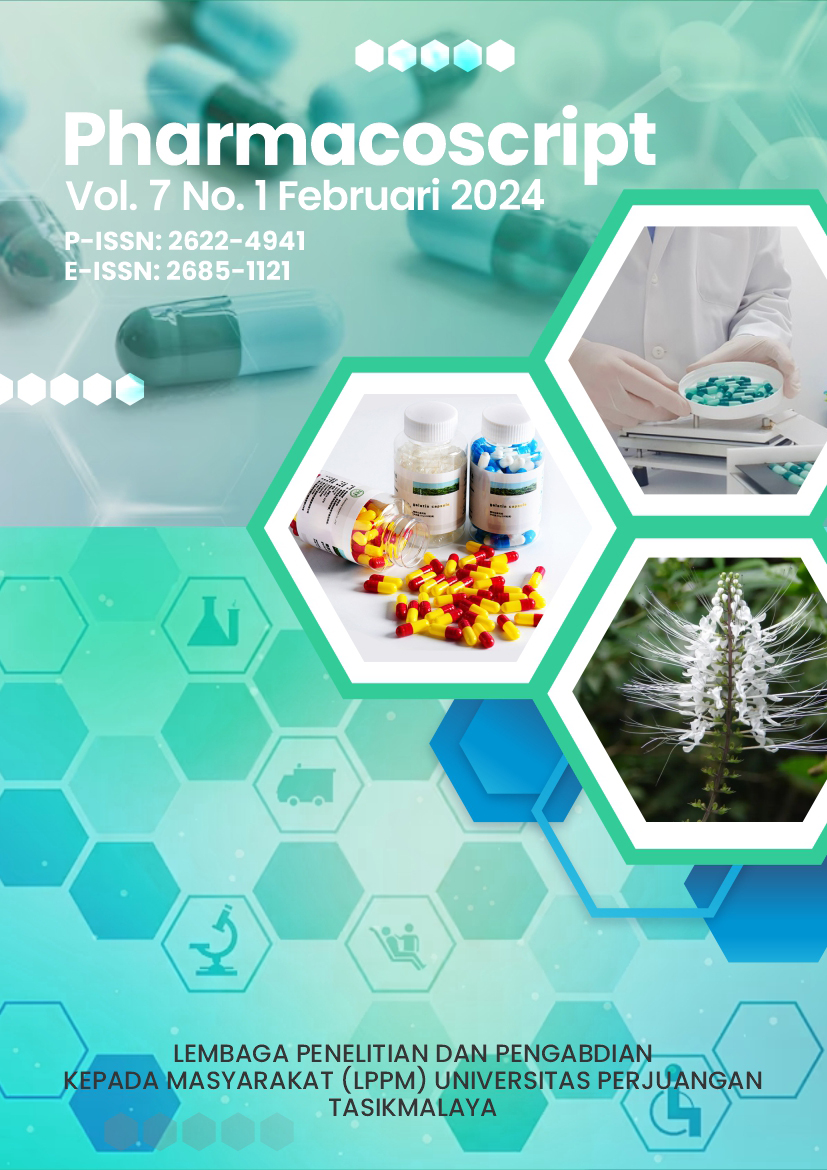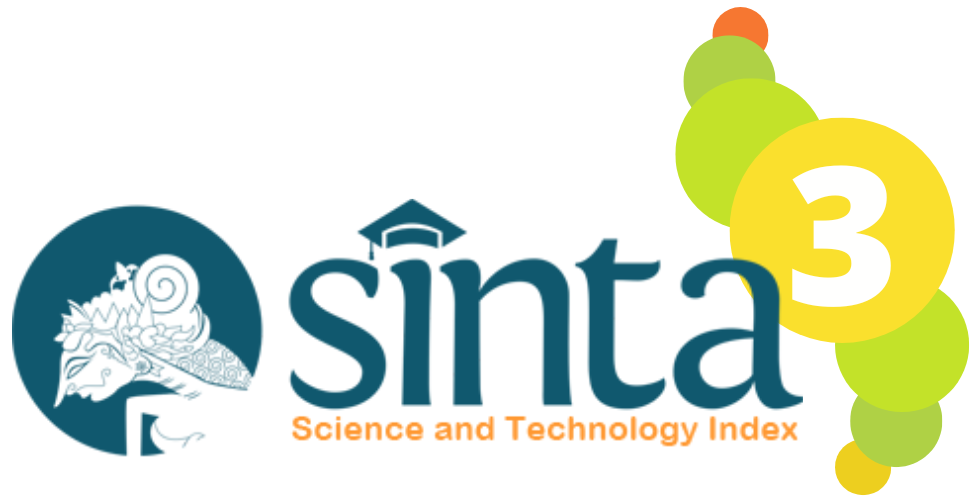SERUM ANTIAGING KOMBINASI EKSTRAK BUAH CEREMAI (Phyllanthus acidus L. SKEELS) DAN KULIT BUAH SEMANGKA (Citrullus lanatus THUNB.)
DOI:
https://doi.org/10.36423/pharmacoscript.v7i1.1530Keywords:
antiaging, Citrullus lanatus, serum, Phyllantus acidusAbstract
Kulit dapat mengalami penuaan atau aging yang didefinisikan sebagai hilangnya keseimbangan homeostatik suatu organisme secara progresif. Indikator aging diantaranya keberadaan hyperpigmentasi yang disebabkan oleh enzim tyrosinase. Banyak Cara yang dapat dilakukan untuk mencegah aging adalah dengan melakukan perawatan kulit menggunakan serum antiaging. Senyawa bioaktif dari tanaman berkembang dan populer untuk digunakan sebagai bahan kosmetik dalam formulasi karena banyak dilaporkan mengandung vitamin, antioksidan, minyak essensial, protein, senyawa fenolik, dan zat aktif lainnya. Buah Ceremai (Phyllantus acidus) diidentifikasi mengandung senyawa asam glikolat dan asam sitrat, sedangkan kulit buah semangka (Citrullus lanatus) mengandung saponin, tanin, alkaloid dan flavonoid. Tujuan penelitian ini adalah untuk membuat formulasi serum antiaging dari kombinasi buah ceremai (Phyllantus acidus) dan ekstrak kulit buah semangka (Citrullus lanatus) sebagai inhibisi enzim tirosinase. Penelitian ini meliputi pengujian aktivitas ekstrak dan sediaan serum terhadap inhibisi enzim tirosinase dengan metode in vitro menggunakan ELISA. Hasil penelitian aktivitas inhibisi enzim tirosinase ekstrak buah ceremai menunjukan nilai IC50 sebesar 9.551 µg/mL dan ekstrak kulit buah semangka 3.304 µg/mL. Inhibisi enzim tirosinase serum F1 mendapatkan nilai IC50 1.137 µg/mL sedangkan F2 sebesar 1.025 µg/mL. Hasil yang dapat disimpulkan bahwa ekstrak kulit buah semangka lebih aktif sebagai inhibisi enzim tirosinase daripada ekstrak buah ceremai tetapi hasil sediaan serum menunjukan hasil yang memiliki potensi sebagai inhibisi enzim tyrosinase.
References
Azmi N, Hashim P, Hashim DM, Halimoon N, Nik Majid, (2014)” Anti-elastase, anti-tyrosinase and matrix metalloproteinase-1 inhibitory activity of earthworm extracts as potential new anti-aging agent”. Asian Pac J Trop Biomed. 4(Suppl 1):S348–52
Batubara I, Darusman LK, Mitsunaga T, Rahminiwati M, Djauhari E. (2010)” Potency of indonesian plants as tyrosinase inhibitor and antioksidan agent”. Journal of Biological Sciences. p. 138–44. Vol. 10.
Batubara. I., Gazali M., & Zamani P. N. (2014) “Potensi limbah kulit buah Nyirih Xylocarpus granatum sebagai inhibitor tirosinase”. Research Gate, 3(3): 187-194.
Chinmay D, Deshmukh1, Anurekha Jain MST. (2015) “Phytochemical and Pharmacological profile of citrullus lanatus (Thunb)”. Biolife. 483–8.
Dolorosa MT, Nurjanah, Purwaningsih S, Anwar E, Hidayat T. (2019). “Tyrosinase inhibitory activity of Sargassum plagyophyllum and Eucheuma cottonii methanol extracts”. IOP Conf Ser Earth Environ Sci. 278(1)
Edori OS, Harcourt P, Marcus AC. (2017). “Phytochemical screening and physiologic functions of metals in seed and peel of Citrullus lanatus (Watermelon)”. International Journal of Green and Herbal Chemistry. E-ISSN: 2278-3229. Vol.6, No.1, 035 – 046
Ernawati E, Farida Y, Taurhesia S. (2021). “ Formulasi Serum Antioksidan Kombinasi Ekstrak Buah Ceremai dan Kulit Buah Semangka” . Majalah Farmasetika. 6(5) 398-406
Garre A, Narda M, Valderas-Martinez P, Piquero J, Granger C (2018). “ Antiaging effects of a novel facial serum containing l-ascorbic acid, proteoglycans, and proteoglycan-stimulating tripeptide: Ex vivo skin explant studies and in vivo clinical studies in women”. Clinical Cosmetic Investigational Dermatology. 11:253–63
Goeswin Agoes (2015) “Sediaan Kosmetik (SFI-9) “. ITB Bandung
Gladvin G, Sudhaakr G, Swathi V, Santhisri K V. (2017). “Mineral and vitamin compositions contents in watermelon peel (Rind)”. International Journal Of Current Microbiology and Applied Sciences. 5(5):129–33
Indriatmoko D, Suryani N, Rudiana T, Kurniah M (2021). “Formulation and physical evaluation of facial cream preparations from Ceremai fruit juice (Phyllanthus acidus (l.) Skeels)”. Pharm Educ.21:87–92
Jayantie DJ, Farida Y, Taurhesia S (2022). “Aktivitas Antioksidan dan Enzim Tirosinase Ekstrak Etanol Buah Gandaria (Bouea macrophylla Grif.) Secara In Vitro”. Pharmacoscript Volume 5 No. 1
Jayanta.K.P & Kwang.H.B (2015) “Novel green synthesis of gold nanoparticles using Citrullus lanatus Rind and investigation of proteasome inhibitory activity, antibacterial, and antioxidant potential”. International Journal of Nanomedicine. 10 7253–7264
Junlatat, J, Fangkrathok, N & Sripanidkulchai, B. (2018). “Antioxidatif and Melanin Production Inhibitory Effects of Syzygium cumini Extracts. Songklanakarin J”. Sci. Technol. 40 (5): 1136-1143
Lukitaningsih E, Saputro AH, Widiasri M, Khairunnisa N, Prabaswari N, Kuswahyuningsih R. (2020) “In Vitro Antiaging Analysis of Topical Pharmaceutical Preparation Containing Mixture of Strawberry Fruit, Pomelo Peel, and Langsat Fruit Extracts”. Indones J Chemom Pharm Anal. 1(1):53
Mardikasari S, Akib N, Suryani Apt (2020) “Formulasi dan Uji Stabilitas Krim Asam Kojat Dalam Pembawa Vesikel Etososm”. Majalah Farmasi dan Farmkologi. 24(2):49-53
Mardhiani D Yani, Yulianti H, Azhary D, Rusdiana T (2017) “Formulasi dan Stabilitas Sediaan serum Dari Ekstrak Kopi Hijau (Coffea canephora var.Robusta) Sebagai Antioksidan”. Indonesia Natural Research Pharmaceutical Journal. Vol.2(2) : 2502-8421
Mustika R, Hindun S, Auliasari N (2020) “Potensi Tanaman Sebagai Pencerah Wajah Alami”. J Sains dan Kesehatan 2(4):558–62.
Neglo D, Tettey CO, Essuman EK, Kortei NK, Boakye AA, Hunkpe G, (2021) “Comparative antioxidant and antimicrobial activities of the peels, rind, pulp and seeds of watermelon (Citrullus lanatus) fruit”. Science African. 1;11: 00582
Pratsinis H, Kletsas D, (2019) “Special issue “anti-aging properties of natural compounds.” Cosmetics. 6(4):1–2
Roselan M , Ashari S NHF, Mohamad SMMF and R (2020) “An Improved Nanoemulsion Formulation Containing Kojic Monooleate: Optimization, Characterization and In Vitro Studies”. Molecules. 1–23
Downloads
Published
Issue
Section
License
Copyright (c) 2024 Eneng Elda Ernawati, Nani Suryani, Sifa Nuramalia, Tarso Rudiana

This work is licensed under a Creative Commons Attribution-ShareAlike 4.0 International License.
Authors who publish with this journal agree to the following terms:
- Authors retain copyright and grant the journal right of first publication, with the work [SPECIFY PERIOD OF TIME] after publication simultaneously licensed under a Creative Commons Attribution License that allows others to share the work with an acknowledgement of the work's authorship and initial publication in this journal.
- Authors are able to enter into separate, additional contractual arrangements for the non-exclusive distribution of the journal's published version of the work (e.g., post it to an institutional repository or publish it in a book), with an acknowledgement of its initial publication in this journal.
- Authors are permitted and encouraged to post their work online (e.g., in institutional repositories or on their website) prior to and during the submission process, as it can lead to productive exchanges, as well as earlier and greater citation of published work (See The Effect of Open Access).









